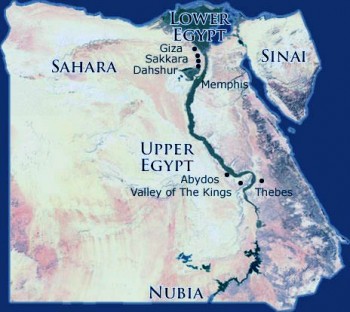The importance of the Nile River in the ancient Egyptian civilization cannot be overstated. The Greek historian Herodotus is often credited with stating that Egypt was “the gift of the Nile.” Flowing into Egypt from an elevation of 6,000 feet above sea level, Nile waters deposited silt, natural fertilizer, along its banks in Lower Egypt, turning the land green and agriculturally prosperous. The sacred waters of the Nile characterized every important aspect of Egyptian civilization.
The Nile River and Egyptian Agriculture
Flowing downward into the Mediterranean Sea, Africa’s longest river becomes one great water source at the ancient city of Khartoum where the Blue Nile and the White Nile merge. The Blue Nile begins at Lake Tana in Ethiopia, where yearly rains produce the waters that would inundate Egypt at the start of their 365 day calendar marking the day that Sirius rose at dawn. The White Nile originates in sub-tropical Africa at Lake Victoria.
Egyptians developed methods of predicting the impact of yearly inundations, recording yearly water levels. The Old Testament story of Joseph in Egypt, most probably as a Vizier to the Pharaoh, illustrates Egyptian concerns regarding the flow of the Nile and its impact on future harvests. Although the story is not corroborated by other historical sources, there were documented periods when Egypt, through careful planning, had sufficient wheat and barley while other areas of the ancient world were experiencing famine conditions.



During the period or season of “inundation,” when Egypt became a virtual sea, the Egyptians used their time to work on state building projects. During the Old Kingdom, the pyramids were constructed through the labor of Egyptians, usually during periods when the Nile flooded its banks. In the Middle Kingdom, flood periods produced canals, temples, and other official edifices that served the entire community.
Sacredness of the Nile
According to Rundle Clark, “the harvest is the peculiar property of Osiris. The Divine Command, the Logos which determines the life-principle in the world is reasserted annually in the flood.” Osiris was the god who taught the Egyptians agriculture. The overflowing of Egypt’s banks by the Nile also recreated the Egyptian creation story which reminded every Egyptian that the Nile waters were linked to life.
According to one of the Pyramid Texts, the Spirit of the Nile declares, “Canal of happiness will be the name of this canal as it floods the fields with plenty.” Interestingly, in the Old Testament story of the Exodus, one of the “plagues” upon Egypt was the turning of the Nile waters into blood. The Old Testament symbolism should not be lost. While the Nile was sacred to the Egyptians, blood, associated with the remission of sins, was a vital part of Hebrew belief.
Disruption of the Nile
The Aswan High Dam was completed in 1971, effectively ending the flooding that for centuries had provided Egypt with fertile, naturally fertilized land. The dam was constructed to control flooding, which had become a problem in Cairo, as well as to provide energy needs. Unfortunately, the disruption of the Nile led to the use of chemical fertilizing which has, over the years, led to toxic repercussions.
Sources:
Nicolas Grimal, A History of Ancient Egypt (New York: Barnes and Noble, 1994).
Sigrid Hodel-Hoenes, Life and Death in Ancient Egypt (Ithaca: Cornell University Press, 2000), translated by David Warburton.
Johr Ray, Reflections of Osiris: Lives From Ancient Egypt (Oxford University Press, 2002).
R. T. Rundle Clark, Myth and Symbolism in Ancient Egypt (London: Thames and Hudson, 1995) p. 84.
